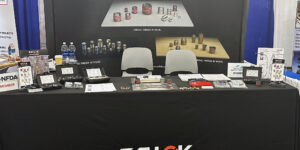TAKE A LOAD OFF
Setup Strategies: Integrated front-load pallet changers enable Cox Machine to standardize jobs, processes, and staging areas – and rethink how they grow their business.
Posted: November 17, 2008
Starting in 1954, Ernest "Bud" Cox began to take Cox Machine, Inc. (Wichita, KS) through several iterations and growth spurts. A 16 ft x 20 ft "shop" containing four machines – a mill, a lathe, a shaper and a drill press (the latter a Christmas gift from Bud's wife, Ruth Ann) – was built from scrap wood.
Once Bud had outgrown this first shop in 1956, he moved the operation into a building in northwestern Wichita that a guy had won in a poker game. There was no indoor plumbing, and it's a bitter wind that howls down through the Dakotas from Canada and across the naked winter plains of Kansas.
By 2001, with Steve Cox now in charge, the company built their current plant, 1/4 mile east of the original Cox Machine site. Their acquisition of 28 mills, 12 lathes, a large number of miscellaneous hones, gundrills, EDMs, grinders, and an enormous amount of fabrication equipment via the purchase of Advanced Manufacturing Technology (Harper, KS), had very nearly outpaced floor space.
So how does this history translate into one of the finest aerospace machining operations in Wichita?
Jason Cox, the chief technology officer of Cox Machine, has watched the company's growth from a slightly different view than perhaps others in the company. He's a technical guy, a graduate engineer, a guy who thinks about tools and their most effective use, about lean and cellular manufacturing, and about Six Sigma and Kaizen.
"We see a continued and strong focus on lean and cellular manufacturing," he says. "That's the way to go. We're going to invest in new technology: hard technology such as our machining centers, and soft technology in the way our staging areas are set up. That's where we feel we need to go. We feel like we've done a good job so far, but we see a lot of room for improvement."
The company currently occupies 75,000 sq ft overall and employs 163 in two locations. All of the machining and assembly is done in Wichita. Just a short run down the road in Harper, all of the fabrication is performed in the facility Cox acquired from AMT.
"We primarily make structural and control system components and assemblies for Cessna, Spirit AeroSystems, Hawker Beach, Eclipse, Boeing and a bunch of others," states Cox. "But we've come to realize that focusing just on Wichita wasn't broad enough, so we looked beyond and found other clients in various parts of the country and beyond. We now do some work in Turkey and Italy, but I think all of that work ends up back on Boeing products."
Cox explains how awful the labor market in Wichita really is right now. Though business is good, it is impossible to find qualified help. "Our challenge is to grow with the people we have without overworking them," he says. "We don't want to make them work twice as hard. We want them to work the same amount of time (three shifts a day), but produce more product, more efficiently and at a better quality. We also want to standardize our processes through our lean and cellular initiatives, with equipment that lets us do that and use people with fewer skills, if the need be."
FRONT END INVESTMENTS
One destination where Cox wants to go can be seen in the recent acquisitions of two Bridgeport XR 1000 APC vertical machining centers. These two new VMCs feature integrated front-load automatic pallet changers, twin 40 in x 20 in palettes and 12,000 rpm, 40.2 hp, and 40-taper Big Plus direct drive spindles.
They are quick, too, with a rapid traverse rate of 1,890 ipm and X, Y, Z acceleration/deceleration of 138 in, 177 in, and 177 in/sec², respectively. With X, Y and Z travels of 20 in x 24 in x 23.6 in, a workload capacity of 660 lb per pallet, and the ability to accommodate workpieces up to 13.8 in tall, these new VMCs are suitable for a diverse range of jobs and machining applications.
"Earlier, we had standard 3-axis vertical mills that were aging," says Cox. "We've chosen these new machine tools as the vehicle to drive our efficiency improvements in our vertical milling operations. On the standard vertical, you can't turn the spindle while you're changing over and loading parts, but on these you can. So one of these machining centers can easily replace the two conventional verticals."
Between the increase of spindle utilization (from 52 percent to 93 percent), the faster rpm and greater horsepower, plus the 48-tool ATC with rapid chip-to-chip change times, the company was able to replace the two older verticals with a single VMC.
"It's nice to watch the transition from two older verticals moving out, one new VMC moving in," remarks Cox. "Since that worked so well, we did it again – two out and one in. We plan to continue to do this kind of waste removal from the value stream because it's a hallmark of lean manufacturing. Translating this into numbers, we had roughly $22 million in sales for 2007 and our growth target is $35 million by 2010. This allows us to grow our business without unnecessary workforce or footprint expansions. We have a terrific workforce here, and our goal is to grow as much as possible with them by improving our technology."
A typical job for these new VMCs would be a smaller, roughly 4 cu in envelope size part made of steel or aluminum that is going to be hogged out and high usage. Target parts are machined complete, with no secondary honing or turning operations. "We manufacture part of the latch system, called the socket, that holds the cabin door closed on Cessna business jets," states Cox. "These sockets are about 2 in x 3 in x 0.5 in and are manufactured from stainless steel. We produce four variations, for a total of 1,100 parts per year."
The company also manufactures several brackets and stiffeners for Spirit AeroSystems that go into the 737 fuselage. These components tie pieces of the structure together and are hidden from view in the finished plane. They are machined from aluminum and range from 2 in x 2 in x 1 in to 3 in x 3 in x 12 in. The company produces 350 of each bracket per year. The stiffeners are machined from a 10.5 lb block, but have a final weight of less than 0.5 lb.
"We typically set up all three or four operations of a bracket on one table and a different bracket on the other table, again requiring three or four operations," explains Cox. "The automatic two-station rotary pallet swaps the tables in and out. Sometimes we run a larger part, such as a stair-step for Hawker Beech, that has two operations. In that situation, we'll set up one operation on each table. But we're typically going to do the smaller parts. Any required deburring takes place as the parts come off the machine. After that, the parts go out for final processing. We're essentially getting a complete part, minus the sourced finishing operations (NDI, painting, etc.) with the cycle of each pallet."
Cox says that cycle times of about 15 minutes are average for the brackets. Regarding precision and rigidity, the direct drive spindles use face and taper contact at the tool holder to increase rigidity. Because of the increase in rigidity, stability and precision, "we can run 2 in and 3 in extended length face mills considerably faster than we could on a conventional 40 taper machine," adds Cox. "We also debur and reduce tool chatter at the same time."
In aluminum, which is the most-often-machined material, Cox says on the brackets they can run a 2 in diameter face mill, 506 ipm with a 0.125 in depth of cut. "If we're running carbide," Cox says, "we can run a 0.750 in carbide rougher at 300 ipm with 0.250 in depth of cut. So, we can hog the material out pretty quickly."
Holding tolerances is another bright spot for the new VMCs. "Some of the Spirit brackets have bearings pressed in before they are installed. We can interpolate the tight-tolerance holes that the bearings press into and hold 0.0005 in on the bore, which is pretty darn good," states Cox. "Most of the brackets we machine don't require that kind of precision, but when we do have to interpolate precision bores we know that we can easily do 0.0005 in. On parts like the sockets, we are only required to hold the profile within .010 in, which is very, very easy for these new VMCs. We're running shrink fit holders on everything with solid carbide tools or inserted tools, so in aluminum our tools are going to last through 10 to 15 jobs. It's not like parts per tool; it's more like jobs per tool, and its 10 to 15 jobs before we have to change."
Cox continues, "We are focused very keenly and putting a lot of time into lean, which translates into reduced customer lead time. Changeover is right smack in the middle of a lean process. The changeovers we're seeing with the new machining centers are under an hour for all the parts. Most of that happens while the spindle is running another part, so it's off line and external. We continue to improve as we increase the standardization of the jobs that run on the machines. Under an hour is not that great a changeover . . . I'd like to get it below that."
Cox goes on to add, "A few years ago we ran six month's inventory on all our customers' parts, because our setup times dictated that. We'd run six months and then hold the inventory for our customers. Reducing our setups to below the one-hour mark allows us to reduce our batch sizes. Now we run a month's inventory for our customers that may be only 24 to 40 parts. Running one month's supply as opposed to a six-month quantity really makes a difference. It benefits our customers and us. Our inventory turns go up, our available cash goes up and the customer gets his parts faster. Nobody loses."
EVOLUTION INTO SINGLE-MACHINE CELLS
Cox notes that what's evolving is really interesting: each new machining center is running as an individual machining cell. "With the integrated front-load pallet changer, we can actually create a one-piece flow in a cell with one machine. Plus, the 48-tool ATC lets us run a catalog of standardized tools so we don't have to swap out the cutting tools. This helps, obviously, in that we run the same tools all the time," notes Cox.
By looking at the new VMCs as cells, Cox tries to load them with stable and repeatable work, such as the brackets and sockets. "Because of this arrangement, we haven't entered new markets, but we have gone after work that's a bit of a specific breed: small envelope, high quantity, and long-term contract," explains Cox. "When we operate this way, we're able to invest more in the front end of the cell, into standardization of job and process, into our staging areas," he continues. "We end up with reduced lead times for the customer and a lot quicker response time to forecast changes or engineering changes. It's the same market, but we now target a specific type of part to put through the cells to give us a competitive advantage over conventional VMCs."
Cox Machine now offers dramatically reduced lead times for the parts they run on these machines. That's a huge advantage in Aerospace Town or, for that matter, Anywhere Town.
– – – – – – – – – – – – – – – – – – – – – – – – – – – – – – – – – – – – – – – – –
Cox Machine, Inc., 5338 West 21st Street, Suite 100, Wichita, KS 67205, 316-943-1342, Fax: 316-943-8248, info@coxmachine.com.
Hardinge Inc., One Hardinge Drive, Elmira, NY 14902-1507, 607-378-4396, Fax: 607-735-0570, www.hardinge.com.









